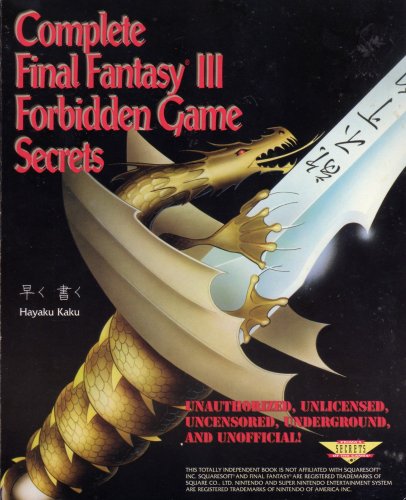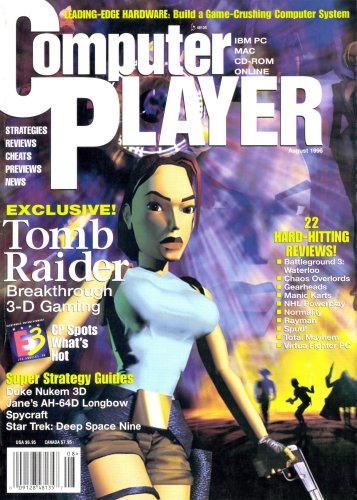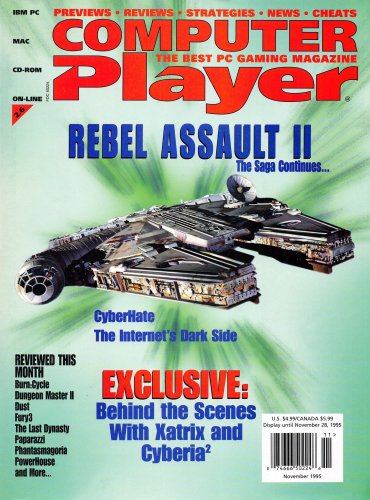About This File
Holy cow, you guys, this book.
This is one of the most ridiculous guides I've ever owned.
Back in 1994, Final Fantasy III was released in the US, and like many people, I went absolutely ga-ga over the game. It's my favorite entry in the series, and I've beaten it multiple times and on multiple platforms, including the Game Boy Advance version with the extra content. In my obsessive quest to learn everything I could about the game though, I bought every magazine and book I could find about it, including Nintendo's own official guide and Peter Olafson's full-colour guide. And then...there's this one...
Part strategy guide, part fanfic, Complete Final Fantasy III Forbidden Game Secrets is a nearly 500-page tribute to absurdity and lies.
The author's name, "Hayaku Kaku", is written as '早く書く' in Japanese. This isn't actually a name, it's a fragment meaning "fast write", and it's a clue to why this guide is so bizarre. See, Final Fantasy III (or Final Fantasy VI as it's now known) is a massive game, and as noted in the introduction, not one you can finish over the course of a three-day rental. Writing a guide to a game that large requires an exceptional lead time if you're planning to match the game's release date, and from the contents of the book, it's easy to ascertain that the author (in this case, Bill Kunkel, aka "The Game Doctor" himself, with assistance from another writer named Ken Vance) was working off pre-release materials.
One of the necessities for squeezing all of the story into the cart, as related by translator Ted Woolsey in an interview, was re-naming the bulk of the enemies, items, spells, and Espers in the game, in order to fit into the character limits imposed by the game. What's odd about this book is that it gets almost all of the character names and spell/Esper names correct, even when it comes to the bizarre spellings imposed by Woolsey to comply with the aforementioned character limits ('Fenix' instead of 'Phoenix', etc...). But the items? Almost all the item names in this guide are completely incorrect--it's likely the item list was among the last things Woolsey worked on, since the majority of his effort was likely focused on the game's massive story. If that's the case, it's almost certain Kunkel and Vance were working off incomplete information and a near-zero knowledge of the Japanese language. More credence is given to this theory since one of the screenshots includes the original Japanese "Bar" sign, which was censored by Nintendo, and read "Cafe" in the US edition of the game.
'Spears' are translated as 'spheres' for some reason. Item names, as noted, often bear no resemblance to their final forms. What's more, the explanations of item abilities and magic spells often read as though someone gave them a very basic, machine-like translation from the original which were never edited for clarity. (Edit: see the update below, but this is exactly what happened).
The maps, maps, and more maps hyped on the back cover are likewise odd. These are not maps, exactly...more like someone took pictures of the screen, printed those pictures out, then placed a sheet of tracing paper over them and drew over every building, tree, hill, stream, and other feature, but never bothered to fill in any of the information. Thus, what you get are a bevy of hand-drawn maps that show the entire area...but are almost completely worthless for all the work put into them, since they don't point out any useful features.
Even as a walkthrough or secrets guide, the book is deficient. It will point out what items can be found in each area (well, most of them at any rate...Kunkel and Vance didn't find a lot of the off-the-beaten-path goodies), but it does not explain where any of them actually are in relation to the map, or what steps might be necessary to uncover them. In addition, a lot of the walkthrough is just plain incorrect in literally dozens of places. It's impossible for anyone well-versed in the game to go more than 2-3 pages without finding another mistake, whether it's a simple mistranslation or flat-out misinformation like: claiming you can earn experience in the "Beastfield" (the Veldt), when in fact, battles there don't earn you any XP; claiming it's possible to get Shadow back into the party via betting items at the Coliseum if you didn't wait for him on the Floating Continent; claiming Locke gains the ability to pick locks as the story continues; saying Celes can use her 'Runic' ability to learn spells faster; a screenshot of a character suffering the 'Imp' status effect incorrectly labeled as 'zombified' by the caption; claiming the 'Quartr' spell reduces the target's HP by 1/4th, when it actually results in a 75% reduction...the list goes on and on.
Speaking of lists, while the book impressively details the Items, Magic, and Espers available in your quest, it also omits an awful lot of other useful lists which other guides did not. These include a list of Gau's available Rages (and the enemies he needs to fight in order to acquire them), a list of items bet & won at the Coliseum, and a list of enemies from whom Strago can learn his different Blue Magic spells.
Also omitted are seemingly obvious things you'd want to point out in a strategy guide: while it explain that calling the Merton esper in combat causes a raging inferno to scream across the battlefield, it neglects to mention this afflicts both the enemies and your party. Now, sure, you're going to learn this as soon as you use it the first time, but knowing an attack could nuke my team BEFORE I use it is kind of the point of a strategy guide, right? Likewise, there's no indication that the Cursed Shield (or the "Bloody Shield" as this book refers to it) can be un-cursed, or that you can equip a Ribbon in order to remove nearly all the negative effects your character will suffer while trying to do so. The book assumes Cid will die, when it is in fact possible (and rather easy) to keep him alive.
I seriously could go on for pages about everything wrong with this guide. There are a lot of books over the years which I have no problem labeled shameless cash grabs, but the level of hyperbole this book builds on its back cover compared to the results it delivers between the pages is a disconnect of truly epic proportions. Download this and read it to understand the nightmare which was the world of video game strategy guides in a pre- (or at least very young) Internet age, marvel at its inconsistencies, and boggle at the fact they were willing to charge $14.95 US (or 2.89 gold flemkes in "East Domo").
In an old forum post at the J2Games website, which is no longer accessible since they removed their forum, Bill Kunkel spilled the beans about writing this book, and how much of a nightmare the project was. I almost feel sorry for him, and got the impression from reading it years ago that this project very quickly spiraled out of control in terms of the time they assumed it would take to write, and the results here speak for themselves. The good Game Doctor is no longer with us, but it's a shame his spirit is forever associated with this absurdity.
Enjoy! 
Update: I discovered, to my delight, that Kunkel's recollections about working on this game guide in that old forum post on J2Games were collected in one of the chapters in his autobiography, Confessions of the Game Doctor. I've corrected some things in the above writing which I got wrong due to my own faulty memory (chief among them: his co-author was not Rusel DeMaria, but Ken Vance), but I'm reproducing this part of the book so you can see exactly what went into the creation of this guide.
It was actually worse than I remembered! ![]()
QuoteBut nothing could equal the experience of writing the strategy guide to Final Fantasy III. Prima couldn’t do business with Final Fantasy publisher Square, but [Ben] Dominitz [founder of Prima] was bound and determined to produce a guide anyway, albeit an unofficial one. They also needed it in about a week. I actually laughed when I heard that one. But no, I was assured, they had solved the problem! You see, Square (then Squaresoft) published its games in Japan before they appeared in the US. So Prima had gone out and purchased several Japanese strategy guides from which we could, umm, “borrow” our ideas.
Hey, I’m no saint. But I’m a sinner who can’t read Japanese, so the books were going to be something less than helpful unless we could find someone who could. I turned, therefore, to our local university, UNLV (the University of Nevada at Las Vegas) and found a lovely Japanese professor who was literate in both English and Japanese. Her only drawback was the fact that she knew absolutely nothing about games and spoke with a very strong accent.
She would translate the various texts and Ken Vance and I would write it all down as best we could. It was a nightmare. In fact, at the end, like an incompetent mechanic who takes his car apart and reassembles it, only to
discover hundreds of “spare parts” still unused, we had page upon page of magical items that didn’t seem to appear anywhere in the game, many of which made no sense whatsoever.One item that was particularly nettlesome was the “rance”. They came in several flavors - silver, gold, magic - but what the heck were they? Then one day as Ken and I sat at the desk, attempting to assemble the puzzle pieces, I had a revelation. I laughed for about five minutes, unable to speak. Finally, I was able to communicate the solution to Ken: “It’s… hahahahaha… NOT a RANCE…hahahaheehee…it’s a…LANCE!” We both literally tumbled to the floor, clutching our stomachs in a helpless fit of glee. Later, after we composed ourselves, an entire row of puzzling words fell into place like dominoes. The “Randwum” was the “Land Worm,” the “Reader” was the “Leader,” “Robo” was “Lobo,” and, our personal favorite, “Erika” (Elixir).
This was certainly the worst strategy book I ever helped produce, but fortunately, it was blamed on a pseudonym: “Hayaku Kaku”, which, as I recall, translates into “Really Fast Writers,” “Two Stiffs Completely Faking It,” or something to that effect.
So, there you have it. A strategy guide written by two guys who cribbed all the relevant information about the game by having a local Japanese professor translate bits and pieces of Japanese guide books which Prima imported instead of actually playing through the game (something they apparently didn't even have access to).
You really can't make this up. ![]()












.thumb.jpg.e5a35c4ac09cc20c78cc606bd85bd370.jpg)




480.thumb.jpg.6277cb1a21f0d6215fb11a759fb0ca15.jpg)
Recommended Comments
Join the conversation
You can post now and register later. If you have an account, sign in now to post with your account.
Note: Your post will require moderator approval before it will be visible.